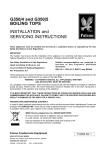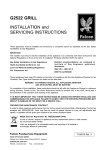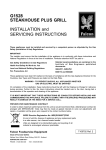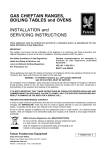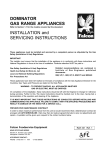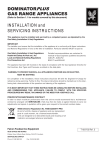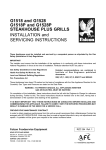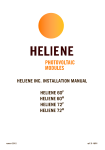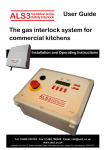Download Falcon 350 Gas Griddle Installation Instructions
Transcript
G350/7 and G350/8 GRIDDLE PLATES INSTALLATION and SERVICING INSTRUCTIONS These appliances must be installed and serviced by a competent person as stipulated by the Gas Safety (Installation & Use) Regulations. IMPORTANT The installer must ensure that the installation of the appliance is in conformity with these instructions and National Regulations in force at the time of installation. Particular attention MUST be paid to - Gas Safety ( Installation & Use ) Regulations Health And Safety At Work etc. Act Local and National Building Regulations Fire Precautions Act Detailed recommendations are contained in Institute of Gas Engineers published documents : IGE/ UP/ 1, IGE/ UP/ 2 BS6173 and BS5440 These appliances have been CE-marked on the basis of compliance with the Gas Appliance Directive for the Countries, Gas Types and Pressures as stated on the Data Plate. WARNING - TO PREVENT SHOCKS, ALL APPLIANCES WHETHER GAS OR ELECTRIC, MUST BE EARTHED On completion of the installation, these instructions should be left with the Engineer-in-Charge for reference during servicing. Further to this, The Users Instructions should be handed over to the User, having had a demonstration of the operation and cleaning of the appliance. IT IS MOST IMPORTANT THAT THESE INSTRUCTIONS BE CONSULTED BEFORE INSTALLING AND COMMISSIONING THIS APPLIANCE. FAILURE TO COMPLY WITH THE SPECIFIED PROCEDURES MAY RESULT IN DAMAGE OR THE NEED FOR A SERVICE CALL. PREVENTATIVE MAINTENANCE CONTRACT In order to obtain maximum performance from this unit we would recommend that a Maintenance Contract be arranged with SERVICELINE. Visits may then be made at agreed intervals to carry out adjustments and repairs. A quotation will be given upon request to the contact numbers below. Falcon Foodservice Equipment HEAD OFFICE AND WORKS Wallace View, Hillfoots Road, Stirling. FK9 5PY. Scotland. SERVICELINE CONTACT PHONE - 01438 363 000 FAX - 01438 369 900 T100690 Ref. 1 Warranty Policy Shortlist Warranty does not cover :Correcting faults caused by incorrect installation of a product. Where an engineer cannot gain access to a site or a product. Repeat commission visits. Replacement of any parts where damage has been caused by misuse. Engineer waiting time will be chargeable. Routine maintenance and cleaning. Gas conversions i.e. Natural to Propane gas. Descaling of water products and cleaning of water sensors where softeners/conditioners are not fitted, or are fitted and not maintained. Blocked drains. Independent steam generation systems. Gas, water and electrical supply external to unit. Light bulbs. Re-installing vacuum in kettle jackets. Replacement of grill burner ceramics when damage has been clearly caused by misuse. Where an engineer finds no fault with a product that has been reported faulty. Re-setting or adjustment of thermostats when unit is operating to specification. Cleaning and unblocking of fryer filter systems due to customer misuse. Lubrication and adjustment of door catches. Cleaning and Maintenance Cleaning of burner jets Poor combustion caused by lack of cleaning Lubrication of moving parts Lubrication of gas cocks Cleaning/adjustment of pilots Correction of gas pressure to appliance. Renewing of electric cable ends. Replacement of fuses Corrosion caused by use of chemical cleaners. SECTION 1 - INSTALLATION UNLESS OTHERWISE STATED, PARTS WHICH HAVE BEEN PROTECTED BY THE MANUFACTURER ARE NOT TO BE ADJUSTED BY THE INSTALLER 1.1 MODEL NUMBERS, NET WEIGHTS and DIMENSIONS MODEL WIDTH DEPTH HEIGHT WEIGHT WEIGHT mm mm mm kg lbs G350/7 & 7P 350 650 385 38 85 G350/8 & 8P 700 650 385 73 162 A "P" suffix denotes propane operation. 1.2 SITING The griddles can be installed on a table, counter top or alternatively upon a purpose-made stand. The unit can be positioned to within 75mm of a combustible wall at the back and sides. There should be a minimum vertical clearance of 900mm above top edge of appliance flue to any overhanging combustible surface. Important If unit is to be installed with other matching appliances of the Falcon 350 series, the instructions for all units must be consulted to determine the necessary clearance to any combustible rear wall or overlying surface. Some appliances require greater clearances than others, and the largest figure quoted in the individual Instructions will therefore determine clearance for complete suite of adjoining appliances. 1.3 VENTILATION Adequate ventilation, whether natural or mechanical, must be provided to ensure sufficient fresh air for combustion and for removal of combustion products, which may be harmful to health. Recommendations for ventilation for Catering Appliances are given in BS.5440:2. Further, to ensure sufficient room ventilation, guidance on the volume of ventilation air required for different kinds of catering equipment is given in the table. For multiple installations the requirements should be added. Installation should be made in accordance with local and/ or national regulations applying at the time, and a competent installer must be employed. The appliance flue discharges vertically through grille at rear of hob. There must be no direct connection of the flue to any mechanical extraction system or outside air. Siting appliance under a ventilated canopy is the ideal arrangement. EQUIPMENT Ventilation Rate Required ft3/min m3/ min Range, Unit Type 17 600 Pastry Oven 17 600 Fryer 26 900 Grill 17 600 Steak Grill 26 900 Boiling Pan 17 600 Steamer 17 600 Sterilizing Sink 14 500 Bains Marie 11 400 8.5 - 14 300 - 500 Tea/ Coffee Machine 1.4 GAS SUPPLY The incoming service must be of sufficient size to supply full rate without excessive pressure drop. A gas meter is connected to service pipe by Gas Supplier. Any existing meter should be checked, preferably by Gas Supplier, to ensure that the meter is of adequate capacity to supply the unit, and other associated equipment. This is particularly important when a number of units are being installed. Installation pipework should be fitted in accordance with IGE/UP/2. The size of the pipes from the meter to the appliance must be not less than that of the appliance inlet connection, Rp1/2 (1/2" BSP female). An isolating cock must be located close to the appliance to facilitate shut-down during an emergency or routine servicing. The cock must be easily accessible to the user. The installation must be tested for gas-tightness; details are given in IGE/UP/1. The adjustable governor supplied must be fitted to natural gas appliances. 1.5 ELECTRICAL SUPPLY Not applicable to these appliances. 1.6 WATER SUPPLY Not applicable to these appliances. 1.7 HEAT INPUTS (net) NATURAL and PROPANE GAS Model Natural Propane G350/7 & 7P 5.2kW 4.65kW G350/8 & 8P 2 x 5.2kW 2 x 4.65kW 1.8 INJECTOR SIZES NATURAL and PROPANE GAS Burner Main Pilot Natural é2.1mm SIT No. 36 Propane Amal 180 SIT No. 19 1.9 GAS PRESSURE NATURAL and PROPANE GAS Pressure test point is located behind front facia panel. Supply Pressure Burner Pressure mbar inches w.g. mbar inches w.g. NATURAL 20 8 16 6 PROPANE 37 14.8 37 14.8 An adjustable governor Rc1/2 (1/2" BSP) is provided on Natural Gas models. 1.10 BURNER ADJUSTMENTS 1.10.1 Aeration Adjustment - Natural Gas Burners are fitted with fixed injectors. Aeration adjustment is set by manufacturer by means of a screw in burner throat. After setting pressure, flame cone height should be approximately 12mm. 1.10.2 Low Flame Setting The gas control is provided with a low flame setting. Low flame adjustment has been set and sealed by manufacturer by means of a bypass screw in gas tap to approximately one third full rate. SECTION 2 - ASSEMBLY and COMMISSIONING 2.1 ASSEMBLY Place unit in position, and level using feet adjusters. If unit requires to be mounted upon a stand, refer to details supplied with stand. Remove any packing material and ensure that burners are correctly located over injectors. 2.2 CONNECTION TO GAS SUPPLY The unit is furnished with a compression elbow fitting, terminating in an R1/2 thread for connecting to mains. The gas supply piping and connection to unit must be installed in accordance with the regulations listed on the cover of this manual. On Natural Gas appliances, the adjustable governor must be fitted in supply, being securely fixed in a position enabling adjustment to be made during commissioning. DO NOT fit a governor to Propane models. A gas isolating cock must be fitted in supply, in a position readily accessible to operator. 2.3 CONNECTION TO AN ELECTRICITY SUPPLY Not applicable to these appliances. 2.4 CONNECTION TO A WATER SUPPLY Not applicable to these appliances. 2.5 PRE-COMMISSIONING CHECK 2.5.1 Setting Gas Pressure (Natural Gas Only) Connect a suitable pressure gauge to test point located behind facia panel. Light burners in accordance with procedure detailed in User Instructions and set gas pressure as specified in Section 1.9. 2.5.2 Aeration Adjustment Check by observing through inspection aperture and window, that burner cone lengths are in accordance with Section 1.10.1. 2.5.3 Low Flame Check Check by observing through inspection aperture and window, that flame reduces when control is turned to low flame setting in accordance with Section 1.10.2. Further observe that flame is stable. 2.5.4 Gas Tightness After installation, the engineer responsible should check gas tightness and ensure unit operates satisfactorily before hading over to user. 2.6 INSTRUCTION TO USER After installing and commissioning the appliance, hand the User's Instructions to the user or purchaser and ensure that the person(s) responsible understands the instructions for lighting, cleaning and correct use of the appliance. It is important to ensure that location of gas isolating cock is made known to user, and the procedure for its operation in an emergency be demonstrated. SECTION 3 - SERVICING and CONVERSION Important BEFORE ATTEMPTING ANY SERVICING, TURN OFF ISOLATING COCK AND TAKE STEPS TO ENSURE THAT IT CANNOT BE INADVERTANTLY TURNED ON. AFTER ANY MAINTENANCE TASK, CHECK THE APPLIANCE TO ENSURE THAT IT PERFORMS CORRECTLY AND CARRY OUT ANY NECESSARY ADJUSTMENTS AS DETAILED IN SECTION 1. After carrying out any servicing or exchange of gas carrying components - ALWAYS CHECK FOR GAS TIGHTNESS! 3.1 CONVERSION PROCEDURE CHECK LIST For conversion to NATURAL GAS, add correct governor and set burner pressure. For conversion to PROPANE GAS, remove governor from gas circuit. Other considerations: CHANGE INJECTORS ADJUST BYPASS SCREW TO LOW RATE ADJUST BURNER AERATION CHANGE DATA PLATE On completion, re-apply any seals and locking nuts. 3.2 REMOVAL OF CONTROL PANEL Proceed as follows: Remove spillage tray. Pull off gas control knob. Undo fixings in upper flange of facia panel and allow panel to drop down. Withdraw panel sufficiently to enable spark igniter leads to be disconnected at rear before removal. Note When re-fitting spark electrode terminal, ensure it is turned away from manual ignition hole in bulkhead. 3.3 BURNERS Burners should be cleaned periodically to maintain maximum performance. 3.3.1 Main Burner To gain access to burner, remove griddle plate. Remove burner by lifting it slightly at rear. Carefully move it back to clear injector. Injectors may also be removed at this stage if required. Refer to Section 3.4. Clean burner with a wire brush. Ports may be cleared with a suitable metal broach, shaking debris clear, or if possible blowing it away with compressed air. When replacing burner, ensure that rear locating pins are properly located. Check flame cone lengths in accordance with Section 1.10.1. Replace all parts in reverse order and check for gas tightness. 3.3.2 Pilot Assembly To remove, proceed as follows: a) Remove griddle plate, burner and facia panel as previously described. b) Release thermocouple fixing nut and remove thermocouple from assembly. c) Release pilot pipe fixing nut from pilot assembly. Take care not to lose injector removed with nut. d) Undo fixings which secure pilot assembly and remove with electrode and ignition lead. Replace spark electrode if required and re-assemble in reverse order. 3.4 INJECTORS 3.4.1 Main Injector Lift off griddle plate and remove burner as detailed above. Injectors may now be unscrewed. Soak it in a suitable solvent to remove any debris and wipe with a soft cloth. Do not use metal objects to clear injector hole. Check face-to-face seals are clean before re-fitting. 3.5 THERMOCOUPLE To remove, proceed as follows: a) Remove griddle plate, burners and control panel as detailed in the relevant sections of this document. b) Undo tubing nuts at both pilot end and gas control. c) Manoeuvre thermocouple clear. When fitting a new thermocouple, coil excess in a similar manner to original. Take care not to bed tubing to less than a 12mm radius. 3.6 PIEZO IGNITER/SPARK ELECTRODE 3.6.1 Piezo Igniter To remove, proceed as follows: a) Remove facia panel. b) Pull off igniter lead and, from inside, remove nut which secures igniter to facia panel. Replace parts in reverse order and check that pilot ignites from spark. Refer to User Instructions for lighting procedure. 3.6.2 Spark Electrode a) Remove griddle plate and facia panel. b) Release thermocouple tubing nut and remove thermocouple from pilot assembly. c) Remove spark ignition lead from electrode by releasing M4 securing nut. d) Release tubing nut which secures electrode to pilot assembly and remove electrode. Replace parts in reverse order. Note When re-fitting spark electrode terminal, ensure it is turned away from manual ignition hole in bulkhead. 3.7 GAS TAP To gain access to gas control, remove control panel as detailed in Section 3.2 and proceed as follows: a) Undo nut securing burner feed pipe to control. b) Release pilot tubing nut from control and ease pilot tube clear of location. c) Remove fixings which secure control to float rail. d) Manoeuvre control to enable thermocouple removal. e) Withdraw control. When replacing control, ensure sealing gasket is in a serviceable condition and check gas tightness. To clean and lubricate tap, proceed as follows: f) Undo screws that fix front securing plate and at the same time, hold plate against internal spring pressure. g) Carefully withdraw plate, complete with operating spindle. h) Withdraw exposed rod, spring, brass washer and sealing washer. Take care not to lose any of these small parts. j) Withdraw plug and clean it with a soft rag. Also clean mating hole in control body. Sparingly re-grease plug with an approved heat resistant grease. Re-assemble strictly in reverse order. Take care with central pin assembly. i.e. Fit spring to pin first, then brass washer and finally rubber sealing washer. When inserting assembly into plug, ensure sealing washer fits snugly into recess at bottom of hole in plug. When re-assembling operating spindle, ensure that niting pin engages in the plug slot. Adjusting Low Flame Setting Low flame setting is adjustable by means of a screw on control front. Refer to Figure 1 and Section 1.10.2. If it is necessary to adjust flame, adopt the following procedure: k) Turn adjusting screw fully clockwise, then unscrew approx. Natural Gas - 1/2 to 3/4 turn. Propane Gas - 1/3 to 1/2 turn. m) Light burner and turn to low flame setting. n) Observe that flame is stable and if required, carefully adjust screw within the limits given for satisfactory operation. Turning screw in an anti-clockwise direction will increase flame and vice-versa. Low flame setting screw On two burner models, both burners require adjustment. When replacing control, ensure sealing gasket is in a serviceable condition and check gas tightness. Take care not to bend thermocouple tubing to less than 12mm radius. 3.8 GOVERNOR This applies to Natural Gas appliances only. The type of governor used is maintenance free. Check that blue dust cap covering vent is fitted and in good condition. This protects breather hole. SECTION 4 - SPARES When ordering spare parts, always quote appliance type and serial number. This information will be found on the data plate, located at unit rear. In addition, the serial number is also printed on an identification label on the unit front.






